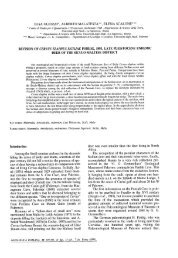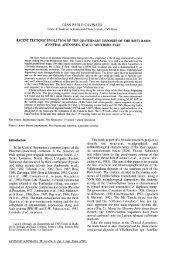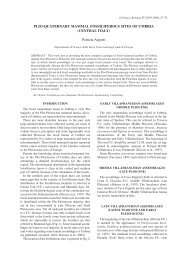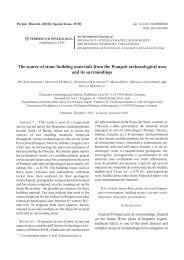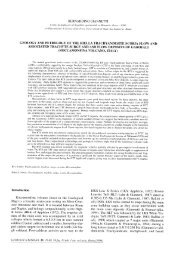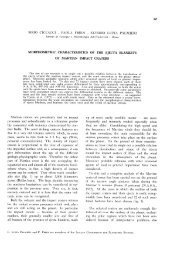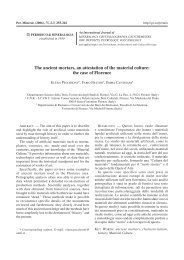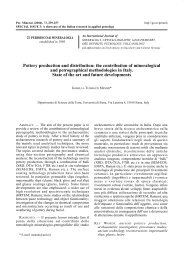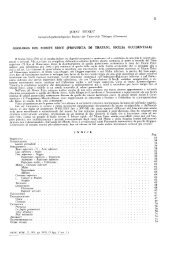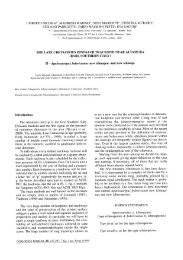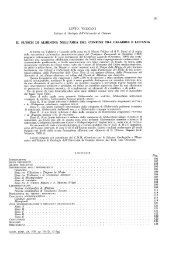Petrographic characterisation of polished stone axes from Neolithic ...
Petrographic characterisation of polished stone axes from Neolithic ...
Petrographic characterisation of polished stone axes from Neolithic ...
Create successful ePaper yourself
Turn your PDF publications into a flip-book with our unique Google optimized e-Paper software.
Per. Mineral. (2002), 71, SPECIAL ISSUE: Archaeometry and Cultural Heritage, 87-100 http://go.to/permin<br />
PERIODICO di MINERALOGIA<br />
established in 1930<br />
An International Journal <strong>of</strong><br />
MINERALOGY, CRYSTALLOGRAPHY, GEOCHEMISTRY,<br />
ORE DEPOSITS, PETROLOGY, VOLCANOLOGY<br />
and applied topics 0/1 Environment, Archaeometry and Cultural Heritage<br />
<strong>Petrographic</strong> <strong>characterisation</strong> <strong>of</strong> <strong>polished</strong> <strong>stone</strong> <strong>axes</strong><br />
<strong>from</strong> <strong>Neolithic</strong> Sardinia: archaeological implications<br />
GIOVANNANGELA BERTORINO! *, MARCELLO FRANCESCHELLI! , CARLO LUGLIE 2 ,<br />
MARCO MARCHI! and STEFANO COLUMBU!<br />
! Dipartimento di Scienze della Terra, Universita di Cagliari, Via Trentino 51,1-09127 Cagliari, Italy<br />
2 Dipartimento di Scienze Archeologiche e Storico-Artistiche, Universita di Cagliari,<br />
Cittadella dei Musei, 1-09124 Cagliari, Italy<br />
ABSTRACT. - In Sardinia, <strong>polished</strong> <strong>stone</strong> <strong>axes</strong><br />
appear in early <strong>Neolithic</strong> communities (VI<br />
millennium B.C.) and are found up to the beginning<br />
<strong>of</strong> the Copper Age.<br />
Classification <strong>of</strong> <strong>polished</strong> <strong>axes</strong> <strong>from</strong> western<br />
central Sardinia has been redefined archaeometrically<br />
in a preliminary sampling <strong>of</strong> specimens found in<br />
open-air settlements. In the studied <strong>Neolithic</strong> sites,<br />
«nephrites» make up 95% <strong>of</strong> all examined<br />
lithologies. Two main groups may be distinguished,<br />
characterised respectively by the presence or<br />
absence <strong>of</strong> epidote. «Nephrites» are made up <strong>of</strong><br />
actinolite or tremolite, chlorite, ±epidote, and Feoxide.<br />
The other <strong>stone</strong> <strong>axes</strong> are composed <strong>of</strong><br />
glaucophane schist, metadiabase, andalusite<br />
hornfels, and phonolite.<br />
The extensive occurrence <strong>of</strong> lithotypes <strong>from</strong><br />
outside Sardinia, mainly «nephrite», which was<br />
commonly used to produce the mainland <strong>axes</strong>,<br />
chiefly in the <strong>Neolithic</strong> villages <strong>of</strong> northern Italy, is<br />
confirmed. Axes made <strong>of</strong> jadeitite or eclogite seem<br />
to be absent or very rare. Conversely, semi-finished<br />
samples found in Sardinia bear witness to raw<br />
materials or rough-casts acquired <strong>from</strong> the mainland.<br />
One axe made <strong>of</strong> volcanic rock <strong>from</strong> Montiferro is<br />
<strong>of</strong> particular interest, since it may also document<br />
local production <strong>of</strong> <strong>stone</strong> <strong>axes</strong>.<br />
RIASSUNTO. - Asce in pietra levigata sono<br />
ampiamente note nella Sardegna preistorica. Esse<br />
fanno la lora comparsa nelle prime cornunita<br />
neolitiche (VI millennio a.C.) e perdurano fino<br />
* Corresponding author, E-mail: bertorig@unica.it<br />
allteta dei primi metalli. Questa ricerca sulla<br />
definizione tipologica delle asce in pietra levigata<br />
della Sardegna e basata su determinazioni<br />
archeometriche effettuate su un campionamento<br />
preliminare di manufatti provenienti da alcuni<br />
insediamenti all' aperto della Sardegna centrooccidentale.<br />
Nei siti neolitici studiati il 95% dei litotipi delle<br />
asce in pietra levigata e costituito da «nephriti». Le<br />
«nephriti» possono essere suddivise in due gruppi a<br />
seconda che contengano 0 siano prive di epidoto.<br />
L' associazione mineralogica ecostituita da actinolite<br />
e tremolite, clorite, ±epidoto e ossido di ferro. Le<br />
altre litologie trovate sono: uno scisto a glauc<strong>of</strong>ane,<br />
un metadiabase, una cornubianite ad andalusite e<br />
una fonolite.<br />
Questi dati confermano una massiccia presenza di<br />
litotipi di origine esotica, che sono simili a quelli<br />
frequentemente impiegati nella produzione di<br />
manufatti continentali, soprattutto nei centri neolitici<br />
dell'Italia settentrionale.<br />
Sembrano invece mancare, 0 essere molto rare,<br />
asce in giadeitite e in eclogite.<br />
II ritrovamento in Sardegna di esemplari non<br />
finiti, costituiti da litotipi di provenienza<br />
continentale, suggerisce una parziale lavorazione in<br />
loco del materiale grezzo.<br />
La presenza di un' ascia in fonolite del Montiferro<br />
attesta anche una produzione locale dei manufatti in<br />
pietra levigata finora non documentata.<br />
KEY WORDS: <strong>Neolithic</strong> <strong>polished</strong> <strong>axes</strong>; nephrite;<br />
mineralogy; mineral chemistry; bulk rock<br />
chemistry; Sardinia.
88 G. BERTORINO, M. FRANCESCHELU, c. LUGUE, M. MARCHI and S. COLUMBU<br />
INTRODUCTION<br />
Polished <strong>stone</strong> <strong>axes</strong> are an important<br />
component in <strong>Neolithic</strong> manufacts.<br />
<strong>Petrographic</strong> studies <strong>of</strong> <strong>Neolithic</strong> <strong>stone</strong> <strong>axes</strong>,<br />
carried out in past decades over large areas <strong>of</strong><br />
continental Europe, identify source areas <strong>of</strong><br />
raw materials and allow us to draw patterns <strong>of</strong><br />
the form and directions <strong>of</strong> tool distribution<br />
(Compagnoni and Ricq-de-Bouard, 1993;<br />
D'Amico et al., 1995; Barfield, 1996; Ricq-de<br />
Bouard, 1996; etc.).<br />
Although the study <strong>of</strong> obsidian tools in the<br />
western Mediterranean has highlighted the<br />
increasing importance <strong>of</strong> trade in Sardinia<br />
starting <strong>from</strong> the early <strong>Neolithic</strong>, petrographic<br />
examination <strong>of</strong> <strong>polished</strong> <strong>stone</strong> <strong>axes</strong> has been<br />
neglected, especially when considering their<br />
close connection with the Monte Arci obsidian<br />
implements (Tykot, 1999).<br />
Despite the pioneering work <strong>of</strong> Lovisato<br />
(1886, 1888), analytical studies on the <strong>stone</strong><br />
artefacts <strong>of</strong> Sardinian prehistory, classification<br />
<strong>of</strong> evidence, definition <strong>of</strong> cultural and<br />
chronological indicators are still lacking.<br />
A further problem is the lack <strong>of</strong> data <strong>from</strong><br />
reliable stratigraphical contexts, since even<br />
the most recent publications are mainly based<br />
on archaeological surveys. It is therefore<br />
necessary to create a database <strong>of</strong> all <strong>stone</strong><br />
<strong>axes</strong> in museums and private collections<br />
containing morphological, morphometrical and<br />
petrographical data on each tool.<br />
This paper deals with the petrological<br />
<strong>characterisation</strong> <strong>of</strong> <strong>Neolithic</strong> <strong>polished</strong> <strong>stone</strong><br />
<strong>axes</strong> found in several archaeological sites in<br />
central Sardinia. A petrographical description<br />
is given for all lithologies encountered, and<br />
bulk rock chemical analyses and mineral<br />
chemistry <strong>of</strong> minerals <strong>from</strong> 12 representative<br />
samples are given, with the purpose <strong>of</strong><br />
determining the origin <strong>of</strong> the raw materials.<br />
SITES: GEOMORPHOLOGIC FEATURES<br />
AND CULTURAL COMPLEXES<br />
The <strong>polished</strong> <strong>stone</strong> tools examined here<br />
were found in eight sites in the Oristano<br />
district, central Sardinia (fig. 1): Conca Illonis,<br />
Cuccuru is Arrius, Su Pranu Mannu (near<br />
Cabras), Gribaia (near Nurachi), Interacquas<br />
(near S. Giusta), S. Ciriaco, S. Giovanni (near<br />
Terralba), and Serra sa Furca (near Mogoro)<br />
(fig. 1). All sites lie on the edge <strong>of</strong> more or<br />
less neighbouring marshy lands, or along<br />
important rivers. The landscape is typically a<br />
plain or a gently undulating low alluvial<br />
terrace.<br />
Conca Illonis is a typical large long-term<br />
settlement, lying west <strong>of</strong> the Cabras lagoon<br />
near Oristano on a coastal plain sloping slightly<br />
<strong>from</strong> the Sinis basaltic plateau. Prehistoric<br />
dwellings have been documented by findings<br />
<strong>of</strong> dark anthropogenic soils filled with food<br />
remnants, lithics and potsherds (Atzeni, 1962).<br />
In the past few decades, most archaeological<br />
layers have been mixed by agricultural<br />
ploughing and levelling. On the basis <strong>of</strong><br />
findings <strong>of</strong> chiefly pottery (cultural facies <strong>of</strong><br />
Bonu Ighinu, S. Ciriaco, Ozieri, Subozieri and<br />
Monte Claro), it is hypothesized that a<br />
settlement probably existed continuously <strong>from</strong><br />
the Middle <strong>Neolithic</strong> to the late Copper Age,<br />
and that another one was established in the late<br />
Middle Bronze Age, with the building <strong>of</strong> a<br />
single-tower Nuraghe, now totally destroyed<br />
(Sebis, 1998).<br />
The habitat <strong>of</strong> Cuccuru is Arrius was very<br />
similar to that <strong>of</strong> Conca Illonis. The settlement<br />
<strong>of</strong> Cuccuru is Arrius lies on a stabilised low<br />
dune along the south coast <strong>of</strong> the Cabras<br />
Lagoon, a site well-known in archaeological<br />
literature since the end <strong>of</strong> the nineteenth<br />
century (Zanardelli, 1899). In the late 1970s,<br />
the dune was drained to create a channel <strong>from</strong><br />
the lagoon to the sea. During this digging,<br />
extensive excavations were made in the<br />
settlement area, and a complex <strong>of</strong> partially<br />
underground dwellings, waste accumulation<br />
and food storage areas was found. A few<br />
burials, below or above ground, were also<br />
found. Stratigraphic data revealed a long-term<br />
settlement, lasting <strong>from</strong> the Middle <strong>Neolithic</strong> to<br />
the early Copper Age (Santoni, 1982) but also,<br />
partially, during the Nuragic and Carthaginian<br />
Roman civilisations.
<strong>Petrographic</strong> <strong>characterisation</strong> <strong>of</strong><strong>polished</strong> <strong>stone</strong> <strong>axes</strong> <strong>from</strong> <strong>Neolithic</strong> Sardinia: archaeological implications 89<br />
Fig. I - Location <strong>of</strong> archaeological sites <strong>of</strong> origin <strong>of</strong> studied<br />
<strong>polished</strong> <strong>stone</strong> <strong>axes</strong>. I: Gribaia; 2: Conca Illonis; 3:<br />
Cuccuru is Arrius; 4: Su Pranu Mannu; 5: Interacquas; 6:<br />
San Ciriaco; 7: San Giovanni; 8: Serra sa Furca.<br />
The third settlement is that <strong>of</strong> Su P ra 1/ U<br />
Mannu region near Cabras, a few kilometres<br />
north-east <strong>of</strong> Cuccuru is Arrius. It was found<br />
during non-systematic archaeological surveys<br />
and is located on a low alluvial terrace along<br />
the large Nurechi lagoon, now drained.<br />
Published archaeological findings testify to the<br />
continuous presence <strong>of</strong> humans during the Late<br />
and Final <strong>Neolithic</strong> Ages, with the S. Ciriaco<br />
facies and the Ozieri culture (Baiocchi, 1996).<br />
A larger settlement area is documented in the<br />
subsequent Chalcolithic Subozieri facies. The<br />
same cultural levels and a later Middle Bronze<br />
Age settlement are found at Gribaia (Nurachi)<br />
five kilometres to the north (Luglie, 1998).<br />
The settlement <strong>of</strong> Interacquas was found in<br />
the southern part <strong>of</strong> this area, close to the<br />
eastern coast <strong>of</strong> the Pauli Maiori marsh, along<br />
the boundary between S. Giusta and Palmas<br />
Arborea. A few remains were found during<br />
archaeological surveys, indicatingt an Early<br />
<strong>Neolithic</strong> settlement that was continuous until<br />
the Late <strong>Neolithic</strong> (Luglie, 2002).<br />
South <strong>of</strong> the large Sassu lagoon, which was<br />
drained during the great land reclamation<br />
operations <strong>of</strong> the 1920s, several settlements<br />
have been identified in the Terralba region, on<br />
a coastal plain between the two volcanic<br />
complexes <strong>of</strong> Monte Arci and Monte Arcuentu.<br />
One, located on the S. Giovanni alluvial<br />
terrace, is formed <strong>of</strong> the old watercourses <strong>of</strong><br />
Rio Mogoro and Rio Sitzerri near the S.<br />
Giovanni Lagoon and characterised by the<br />
unique short-term Ozieri settlement, which<br />
developed during the latest <strong>Neolithic</strong> Early<br />
Copper Age (Cossu, 1996). Instead, in the<br />
hinterland, frequent patterns <strong>of</strong> long-term<br />
settlement are found on Quaternary terraces<br />
overlooking the older Rio Mogoro. Here, the<br />
site <strong>of</strong> S. Ciriaco at Terralba persisted <strong>from</strong> the<br />
Middle <strong>Neolithic</strong> to the early Copper Age, and<br />
that <strong>of</strong> Serra Sa Furca at Mogoro <strong>from</strong> the<br />
Middle <strong>Neolithic</strong> to the Monte Claro culture <strong>of</strong><br />
the Middle Copper Age (Atzeni, 1992). At both<br />
sites, secondary Nuragic settlements during the<br />
Late Bronze Age were probably favoured by<br />
good environmental conditions.<br />
STUDY MATERIALS<br />
Fourteen fragments, representative <strong>of</strong> 54<br />
<strong>polished</strong> <strong>stone</strong> tools, were selected for<br />
petrographical analysis on the basis <strong>of</strong> their<br />
macroscopic features. The samples are<br />
comparatively homogeneous and are classified<br />
as <strong>axes</strong> and hatchets; one item may be a striker.<br />
They are usually flat, symmetrical, and<br />
trapezoidal in shape; their cross-section is<br />
generally oval or lenticular, more seldom<br />
rectangular (fig. 2). Borders are rectilinear;<br />
slightly convex edges have a double inclination<br />
and are generally symmetrical. The bases are
90 G. BERTORINO, M. FRANCESCHELU, c. LUGUE, M. MARCHI and S. COLUMBU<br />
Scm<br />
b<br />
Fig. 2 - Polished <strong>stone</strong> <strong>axes</strong> (a, c) and hatchet-amulet (b) <strong>from</strong> Conca Illonis (drawing by C. Luglie).<br />
more frequently convex, at times strongly<br />
convex or rectilinear.<br />
All these artefacts come <strong>from</strong> archaeological<br />
surveys, generally carried out on long-term<br />
settlements dating at least as far back as the<br />
Middle <strong>Neolithic</strong> Age (4000-3250 B.C.). As<br />
regards the cultural and chronological time-<br />
a<br />
scale proposed for prehistoric Sardinia, this<br />
kind <strong>of</strong> tool fits between the Early <strong>Neolithic</strong><br />
and the early Copper Age, and seems to<br />
disappear in the middle <strong>of</strong> the third<br />
millennium B.C. during the Monte Claro<br />
culture. Detailed descriptions <strong>of</strong> the samples<br />
are given below.<br />
c
<strong>Petrographic</strong> <strong>characterisation</strong> <strong>of</strong><strong>polished</strong> <strong>stone</strong> <strong>axes</strong><strong>from</strong> <strong>Neolithic</strong> Sardinia: archaeological implications 91<br />
Conca Illonis (Cabras)<br />
CIC15. Mesial fragment adjacent to the edge,<br />
probably rectilinear; undetermined shape,<br />
lenticular transversal section. Remaining (rem.)<br />
max length 6I mm; rem. max width 20.5 mm;<br />
rem. max thickness 15 mm.<br />
CIC 16. Probably distal fragment <strong>of</strong><br />
undetermined shape, <strong>from</strong> along the right<br />
rectilinear edge; asymmetrical, sub-rectangular<br />
cross-section; double-plain rectilinear edge,<br />
smoothed. Rem. max length 43.5 mm; rem.<br />
max width 46 mm; rem. max thickness 20 mm.<br />
CIC 17. Proximal fragment; probably <strong>of</strong><br />
symmetrical, trapezoidal shape. Inclined<br />
rectilinear base; asymmetrical sub-rectangular<br />
section; repeated attempt at bi-directional<br />
drilling, as seen in the section, with probable<br />
subsequent accidental breakage (secondary<br />
polish?). Rem. max length 27.1 mm; rem. max<br />
width 32.5 mm; rem. max thickness 9 mm.<br />
CIC 18. Distal fragment, flat, probably <strong>of</strong><br />
symmetrical trapezoidal shape; double-plain<br />
asymmetrical edge, thin, chipped, slightly<br />
convex (Convexity index = Cd 2.91: Ricq-de<br />
Bouard, 1983); lenticular cross-section, with<br />
rectilinear symmetrical borders. Rem. max<br />
length 53.5 mm; rem. max width 48 mm; rem.<br />
max thickness 11 mm.<br />
CIC 19. Proximal fragment <strong>of</strong> symmetrical<br />
trapezoidal shape, slightly convex base. Oval<br />
cross-section, with asymmetrical borders. Rem.<br />
max length 54.5 mm; rem. max width 40 mm;<br />
rem. max thickness 12.5 mm.<br />
Cuccuru is Arrius (Cabras)<br />
CA4. Proximal fragment, symmetrical<br />
trapezoidal in shape, with rectilinear or slightly<br />
convex borders; rectilinear base, broken<br />
slantwise. Sub-rectangular cross-section, with<br />
asymmetrical surfaces. One surface shows<br />
traces <strong>of</strong> wear, probably produced by the haft.<br />
Rem. max length 68 mm; rem. max width 49<br />
mm; rem. max thickness 16 mm.<br />
CA5. Proximal fragment; probably <strong>of</strong><br />
symmetrical shape, with rectilinear or slightly<br />
convex borders, like the base; symmetrical,<br />
oval cross-section. Rem. max length 36 mm;<br />
rem. max width 43 mm; rem. max thickness<br />
12.5 mm.<br />
Gribaia (Nurachi)<br />
GRI65. Thick, probably distal fragment;<br />
undetermined shape. Rem. max length 51.5<br />
mm; rem. max width 52.5 mm; rem. max<br />
thickness 16 mm.<br />
GRI67. Trapezoidal asymmetrical shape with<br />
rectilinear borders; completely fragmentary<br />
base and edge; oval section with asymmetrical<br />
flat surfaces. Rem. max length 58.4 mm; rem.<br />
max width 32.3 mm; rem. max thickness 11.4<br />
mm.<br />
San Ciriaco (Ten-alba)<br />
S. CIR30. Distal fragment; trapezoidal<br />
symmetrical shape with rectilinear borders,<br />
transversally broken; slightly convex edge (Cd<br />
1.9), accidentally chipped, with double<br />
symmetrical plane; asymmetrical oval crosssection.<br />
One surface shows deep splintering;<br />
one border shows outlines <strong>of</strong> hammer traces.<br />
Rem. max length 55.5 mm; rem. max width 42<br />
mm; rem. max thickness 16.1 mm.<br />
San Giovanni (Terralba)<br />
SG2. Distal fragment; trapezoidal in shape<br />
with rectilinear borders; double symmetrical<br />
edge contour, slightly convex (Cd 2.05) and<br />
accidentally chipped; lenticular cross-section<br />
with rectilinear asymmetrical borders. Rem.<br />
max length 38.5 mm; rem. max width 39 mm;<br />
rem. max thickness 9 mm.<br />
SG5. Striker? Proximal fragment <strong>of</strong> flat<br />
cylindrical shape, slightly tapered; base with<br />
low convexity. Oval-circular cross-section,<br />
asymmetrical. Remaining outline hammer<br />
traces all along border and contiguous surfaces.<br />
Rem. max length 66.2 mm; rem. max width<br />
46.5 mm; rem. max thickness 34 mm.<br />
Serra sa Furca (Mogoro)<br />
SSF5. Proximal fragment; symmetrical<br />
trapezoidal in shape with rectilinear borders<br />
and broken base. Rectangular asymmetrical
92 G. BERTORINO, M. FRANCESCHELLI, c. LUGLIE, M. MARCHI and S. COLUMBU<br />
cross-section; clear traces <strong>of</strong> sawing on one<br />
edge, high asymmetry between cutting<br />
surfaces. Outlines <strong>of</strong> hammer traces at the<br />
centre <strong>of</strong> both surfaces are preserved. Rem.<br />
max length 44 mm; rem. max width 37 mm;<br />
rem. max thickness 15.7 mm.<br />
SSF6. Distal fragment; trapezoidal<br />
symmetrical in shape with rectilinear borders<br />
severely broken lengthwise and chipped on one<br />
surface; double asymmetrical plane,<br />
accidentally chipped, with a slightly convex<br />
edge (Cd 2.97); asymmetrical oval crosssection.<br />
Outlines <strong>of</strong> hammer traces all over the<br />
surface. Rem. max length 62.3 mm; rem. max<br />
width 34 mm; rem. max thickness 11 mm.<br />
ANALYTICAL METHODS<br />
Minerals were identified by optical<br />
microscopy and X-ray powder diffraction,<br />
using a Philips (PWI710) diffractometer.<br />
Mineral chemistry was determined at the<br />
Centro Studi Geominerari e Mineralurgici,<br />
CNR, Cagliari, on a fully automated ARL<br />
SEMQ electron microprobe operating at a 20<br />
kV and 20 nA sample current. Beam spot size<br />
was approximately 3 mm. Natural olivine,<br />
orthoclase, albite, anorthite, augite, ilmenite<br />
and chromite were used as standards. Raw data<br />
were corrected using the ZAF procedure.<br />
Twelve samples were analysed for major<br />
elements (ICP-AES, whole rock fusion with<br />
meta-borate) and four samples for trace and<br />
rare earth (REE) elements (ICP-MS) at the<br />
Chemistry Labs, Vancouver (Canada).<br />
MINERALOGY AND PETROGRAPHY<br />
CICI5, CICI6, CICI7, CICI8, CICI9, CA4,<br />
CA5, SSF5, SSF6, SG2 - This group <strong>of</strong><br />
<strong>polished</strong> <strong>stone</strong> <strong>axes</strong> may be classified as<br />
«nephrites». Two main groups are<br />
distinguished, depending on whether they<br />
contain or lack epidote (fig. 3a, b). The<br />
«nephrites» reveal two main textural types: one<br />
is fine-grained and made up <strong>of</strong> a felt <strong>of</strong><br />
interlocked needles <strong>of</strong> amphibole, rarely by<br />
coarse-grained amphibole crystals; the second<br />
type contains medium-grained crystals <strong>of</strong><br />
amphibole (0.1-1 mm long) prevailing over<br />
tightly-intergrown amphibole needles. Some<br />
nephrites contain small opaque patches <strong>of</strong> Feoxide.<br />
Table 1 lists the compositions <strong>of</strong> selected<br />
amphiboles, together with structural formulas<br />
based on 23 oxygens.<br />
According to the classification <strong>of</strong> Leake et<br />
al. (1997), the amphiboles are calcic, with a<br />
fairly uniform composition, and plot in the<br />
actinolite or tremolite fields (fig. 4). They have<br />
low Al!" (up to 0.116) and AlvI (up to 0.075)<br />
contents, a high X Mg ratio (0.86-0.92), and Na<br />
contents lower than 0.03.<br />
Chlorite occurs as a colourless matrix<br />
mineral <strong>of</strong> small size or arranged as radial<br />
crystals. Selected compositions are listed in<br />
Table 1. The structural formula was calculated<br />
on the basis <strong>of</strong> 28 oxygens. Si contents range<br />
<strong>from</strong> 5.937 to 6.029 atoms per formula unit<br />
(apfu). The X Mcr ratio ranges <strong>from</strong> 0.77 to 0.91.<br />
Epidote occurs as both anhedral or subhedral<br />
grains, <strong>from</strong> 0.1 to 0.3 mm. A representative<br />
analysis <strong>of</strong> epidote is shown in Table 1. The<br />
structural formula is calculated on the basis <strong>of</strong><br />
12.5 oxygens. Al contents <strong>of</strong> epidote are 2.096<br />
apfu, Ca contents approach the value <strong>of</strong> 1.914<br />
apfu. Iron, calculated as trivalent iron, is<br />
0.941.<br />
SCIR30. This <strong>polished</strong> <strong>stone</strong> axe displays a<br />
granular texture consisting <strong>of</strong> large crystals <strong>of</strong><br />
plagioclase, stilpnomelane, amphibole, chlorite,<br />
ilmenite and apatite. Plagioclase is the most<br />
abundant mineral (up to 50%) and consists<br />
mainly <strong>of</strong> homogeneous plagioclase (18% An).<br />
Amphibole occurs as small elongated grains<br />
«0.2 mm long) growing into plagioclase and<br />
chlorite. Ilmenite crystals are very small «0.1<br />
mm) and highly fragmented. This rock is<br />
tentatively classified as metadiabase.<br />
GRI67. This sample is a fine-grained<br />
blueschist and consists <strong>of</strong> glaucophane and<br />
lawsonite (fig. 3c) with accessory Fe-oxide<br />
(mainly hematite) and minor phengite.<br />
Representative glaucophane, lawsonite and
<strong>Petrographic</strong> <strong>characterisation</strong> <strong>of</strong><strong>polished</strong> <strong>stone</strong> <strong>axes</strong> <strong>from</strong> <strong>Neolithic</strong> Sardinia: archaeological implications 93<br />
c I 0.8mm I d I 0.1 mm I<br />
Fig. 3 - Photomicrographs <strong>of</strong> <strong>polished</strong> <strong>stone</strong> <strong>axes</strong> <strong>from</strong> Sardinia. a: sample SG2, «nephrite»; b: sample CA5, epidotebearing<br />
«nephrite»; c: sample GRI67, glaucophane schist with a patch which recall an angular clast; d: sample GRI65,<br />
phonolite. a, b, c: crossed polar; d: plane-polarized light. Mineral abbreviations according to Bucher and Frey (1994).<br />
phengite analyses are listed in Table 1. The<br />
structural formula <strong>of</strong> blue amphibole was<br />
calculated to 13 cations, except for Ca+Na+K.<br />
According to the classification <strong>of</strong> Leake et al.<br />
(1997), it is a ferroglaucophane, with Al'" and<br />
Al "! contents <strong>of</strong> 0.048 and 1.407 apfu,<br />
respectively, a low X Mg ratio (0.49) and Na<br />
contents <strong>of</strong> 1.89 apfu. The composition <strong>of</strong><br />
lawsonite is very close to the ideal<br />
composition, with negligible Fe contents<br />
(0.032 apfu). Muscovite is a celadonite-rich<br />
phengite with Si <strong>of</strong> 7.056 apfu, K <strong>of</strong> 1.961<br />
apfu, and Mg-i-Fe = 1.249 apfu. Patches with a<br />
larger grain size, which recall angular clasts<br />
made up <strong>of</strong> the same rock matrix materials, are<br />
worthy <strong>of</strong> note (fig. 3c).<br />
505. This rock consists <strong>of</strong> quartz, muscovite,<br />
biotite, andalusite and Fe-oxide. Quartz mainly<br />
occurs as single crystals up to 10 microns<br />
across. Muscovite occurs as either small or<br />
medium-grained flakes with random<br />
orientation. Andalusite occurs as euhedral<br />
crystals or coarse columnar aggregates, and<br />
shows typical pale to pinkish pleochroism. Due<br />
to lack <strong>of</strong> preferred mineral orientation and<br />
similarity with contact metamorphic rocks, this
,<br />
<strong>Petrographic</strong> <strong>characterisation</strong> <strong>of</strong><strong>polished</strong> <strong>stone</strong> <strong>axes</strong> <strong>from</strong> <strong>Neolithic</strong> Sardinia: archaeological implications 95<br />
Tremolite<br />
••<br />
o 8.0<br />
Actinolite<br />
I I<br />
Magnesiohornblende Tschermakite<br />
Ferro-<br />
Ferro-<br />
Ferrohomblende<br />
actinolite tschermakite<br />
7.5<br />
I<br />
7.0 Si 6.5<br />
5.5<br />
Fig. 4 Plot <strong>of</strong> calcic amphibole <strong>of</strong> <strong>polished</strong> <strong>stone</strong> <strong>axes</strong><br />
<strong>from</strong> Sardinia, in classification diagram <strong>of</strong> Leake et al.<br />
(1997).<br />
slightly variable, between 18.65 and 24.16<br />
wt%, while CaO ranges <strong>from</strong> 10.16 to 13.20<br />
wt%. K20 «0.24), Na20 (0.27) and MnO<br />
«0.11) contents are very similar among the<br />
various «nephrites». Compared with chondrite,<br />
Ba, Th, and Sr contents <strong>of</strong> «nephrites» vary<br />
greatly. Rb, Nd, and Sr show a marked<br />
negative anomaly, and Ta and Th show a<br />
positive anomaly. Worthy <strong>of</strong> note is Ti<br />
enrichment with respect to Y and Yb. The<br />
chondrite-normalised REE patterns (Sun and<br />
McDonough, 1989) <strong>of</strong> two «nephrite» <strong>axes</strong> are<br />
shown in fig. 5a. They show LREE enrichment<br />
<strong>of</strong> about 5-100 times, MREE enrichment <strong>of</strong><br />
about 1-20 times, and HREE enrichment <strong>of</strong><br />
about 6-10 times, compared with chondrite<br />
values. Chondrite-norrnalised REE patterns<br />
show a slightly positive Eu anomaly and are<br />
enriched in LREE with respect to HREE.<br />
The glaucophane schist and metadiabase<br />
have similar chemical compositions, except for<br />
P 20S contents and LOI, the latter being higher<br />
in the glaucophane schist. The bulk chemistry<br />
<strong>of</strong> the metadiabase is similar to that <strong>of</strong> Fe<br />
gabbros, with MgO contents <strong>of</strong> 3.51 wt% and<br />
Al203 <strong>of</strong> 14.81 wt%. It is also characterised by<br />
high Ti02 (2.95 wt%) and P 20S (1.10 wt%).<br />
The FeOto/MgO and MgO/CaO ratios <strong>of</strong><br />
metadiabase are 3.70 and 0.45, respectively.<br />
6.0<br />
The REE patterns <strong>of</strong> the latter show a slight<br />
decrease in LREE and flat HREE contents.<br />
According to the Ti/Y and Nb/Y (Pearce, 1982)<br />
and Ti02 and Zr/P 20 S ratios (Floyd and<br />
Winchester, 1975) and the REE patterns, the<br />
protolith may be an igneous alkaline mafic<br />
rock.<br />
The andalusite-hornfels shows Si0 2 <strong>of</strong> 64.82<br />
wt% and Al203 <strong>of</strong> 17.87 wt%. The MgO/Fe203<br />
ratio is 0.28. In the Na20 vs. TiO/Zr diagram<br />
<strong>of</strong> Garcia et al. (1994), the sample plots<br />
between Al-rich shale and normal shale, but is<br />
far <strong>from</strong> immature sand<strong>stone</strong>. The trace and<br />
REE contents <strong>of</strong> these rocks are very similar to<br />
those <strong>of</strong> North American shale (Gromet et al.,<br />
1984).<br />
Phonolite has silica contents <strong>of</strong> 59.94% and<br />
total alkalis <strong>of</strong> 13.9 wt%; CaO and Fe203 are<br />
1.51 and 2.50, respectively. MgO and Ti02 are<br />
less than 0.5 wt%; P 20S is negligible. This rock<br />
was classified as a phonolite according to both<br />
the R1R2 diagram <strong>of</strong> De La Roche et al. (1980)<br />
and the TAS diagram (Le Bas et al., 1986). It is<br />
characterised by high normative nepheline<br />
(about 15 %) and low normative anorthite<br />
(0.12%). This sub-aluminous character is<br />
supported by an agpaitic index <strong>of</strong> 0.998, which<br />
indicates a peralkaline tendency.<br />
DISCUSSION<br />
Mineralogical and petrological <strong>characterisation</strong><br />
<strong>of</strong> the examined Sardinian <strong>polished</strong> <strong>stone</strong> <strong>axes</strong><br />
provides some useful information on their raw<br />
materials. However, conclusions are only<br />
approximate, since only a small number <strong>of</strong><br />
samples was examined. In addition, the<br />
samples represent a group <strong>of</strong> 54 <strong>polished</strong> <strong>stone</strong><br />
<strong>axes</strong> collected <strong>from</strong> the surface, a part which<br />
does not allow precise chronological or cultural<br />
attribution.<br />
The commonest lithologies are «nephrites»,<br />
with very minor glaucophane schist, andalusite<br />
hornfels, and only one sample <strong>of</strong> volcanic rock.<br />
These data are partially consistent with the<br />
raw materials <strong>of</strong> <strong>Neolithic</strong> <strong>polished</strong> <strong>stone</strong> <strong>axes</strong>
98 G. BERTORINO, M. FRANCESCHELU, c. LUGUE, M. MARCHI and S. COLUMBU<br />
Raw materials are unlikely to have come<br />
<strong>from</strong> a single geologic source. The<br />
considerable lithological variations, which<br />
include metapsammite, green<strong>stone</strong>,<br />
glaucophane schist and phonolite, suggest that<br />
the raw materials came <strong>from</strong> various areas.<br />
Nevertheless, except for phonolite, the raw<br />
materials <strong>of</strong> the other <strong>axes</strong> come <strong>from</strong> an exotic<br />
source. This is easy to prove because, in<br />
Sardinia, high-pressure rocks such as<br />
glaucophane schist and «nephrites» are lacking,<br />
whereas glaucophane schist, eclogite and<br />
serpentinite are common in the Alps and NE<br />
Corsica. The Alpine origin <strong>of</strong> the jadeitite,<br />
eclogite, and serpentine <strong>axes</strong> described by<br />
Lovisato (1886) is well ascertained, whereas<br />
the origin <strong>of</strong> the «nephrite», most probably<br />
multiple, is more problematic.<br />
«Nephrite» has been found at several<br />
archeological sites in northern Italy, <strong>of</strong>ten<br />
associated with eclogite and jadeitite. In all the<br />
sites studied, a very small percentage <strong>of</strong> <strong>axes</strong><br />
are made <strong>of</strong> «nephrite». Primary deposits <strong>of</strong><br />
«nephrite» are known in Val de Faller,<br />
Peschiavo, Les Hauderes, Gottard (Swiss<br />
Alps), Isere Valley (France), Sestri Levante<br />
Monterosa (Italy), Mt. Hartz (Germany), south<br />
western Poland, and Pakile (Finland) (Gunia,<br />
1999). Secondary deposits <strong>of</strong> «nephrite» have<br />
been reported <strong>from</strong> morainic deposits in<br />
Scandinavia and Germany (Gunia, 1999).<br />
Glaucophane schists are common both in the<br />
Alps and in Alpine Corsica (Gibbons et al.,<br />
1986). The hypothesis <strong>of</strong> a Corsican source for<br />
both the Sardinian «nephrite» and glaucophane<br />
schist appears attractive, but still awaits<br />
confirmation.<br />
There is petrographical evidence that local<br />
raw materials were used to produce <strong>polished</strong><br />
<strong>stone</strong> <strong>axes</strong> in Sardinia. Phonolite, similar to<br />
that <strong>of</strong> sample GRI65 outcrops extensively in<br />
the Pliocene volcanic complex <strong>of</strong> Montiferro,<br />
central Sardinia. This complex consists <strong>of</strong> two<br />
main magmatic series <strong>of</strong> alkaline affinity<br />
(Beccaluva et al., 1977): one sequence <strong>of</strong> terms<br />
<strong>from</strong> analcite-basanite to tephritic phonolite;<br />
and one, more extensive, containing terms <strong>from</strong><br />
alkaline to mildly-alkaline basalt, to phonolite<br />
(sometimes peralkaline). Some geochemical<br />
features <strong>of</strong> peralkaline phonolite are relatively<br />
high Zr, Hf, Th, and Rb contents, and depletion<br />
in Y, Nb, Ta and intermediate REE. The latter<br />
defines a characteristic V-shaped REE pattern<br />
(fig. 5b) (Beccaluva et al., 1977). Table 1 lists<br />
the chemical analyses <strong>of</strong> phonolitic axe sample<br />
GRI65, which is very similar to peralkaline<br />
phonolite 203F <strong>of</strong> Montiferro. This is<br />
confirmed by the REE pattern, which is<br />
characteristic <strong>of</strong> phonolite <strong>of</strong> the volcanic<br />
series <strong>from</strong> alkali-basalt to phonolite, and by<br />
the aegirine-augite composition <strong>of</strong><br />
clinopyroxene.<br />
One other point which deserves further<br />
exploration is the quality and working <strong>of</strong> raw<br />
materials. Most <strong>of</strong> the implements are finished<br />
tools such as <strong>axes</strong>, chisels and axe-amulets, but<br />
unfinished or rough-hewn instruments made by<br />
hammering have also been found. This<br />
suggests circulation <strong>of</strong> partially processed<br />
materials to be completed locally, as in other<br />
regions <strong>of</strong> Southern Italy (Leighton, 1992).<br />
CONCLUDING REMARKS<br />
The 14 samples <strong>of</strong> <strong>polished</strong> <strong>stone</strong> <strong>axes</strong> <strong>from</strong><br />
central Sardinia allow us to draw the following<br />
conclusions:<br />
1. «Nephrite» <strong>axes</strong> make up 95% <strong>of</strong> sampled<br />
Sardinian <strong>Neolithic</strong> <strong>polished</strong> <strong>stone</strong> <strong>axes</strong>.<br />
2. The origin <strong>of</strong> «nephrite» and glaucophane<br />
schist is undoubtedly exotic to Sardinia, since<br />
these kinds <strong>of</strong> rocks (xnephrites» or highpressure<br />
rocks such as glaucophane schist) are<br />
not known on the island and their occurrence is<br />
precluded, for geological reasons.<br />
3. The <strong>polished</strong> <strong>stone</strong> axe made <strong>of</strong> phonolite<br />
(GRI65) certainly comes <strong>from</strong> a local source,<br />
since its mineralogical and geochemical<br />
features are very similar to the peralkaline<br />
phonolite <strong>of</strong> the Montiferro area.<br />
ACKNOWLEDGMENTS<br />
Valuable reviews by R. Compagnoni (University<br />
<strong>of</strong> Turin) and I. Memmi (University <strong>of</strong> Siena) are<br />
greatly appreciated.
<strong>Petrographic</strong> <strong>characterisation</strong> <strong>of</strong><strong>polished</strong> <strong>stone</strong> <strong>axes</strong> <strong>from</strong> <strong>Neolithic</strong> Sardinia: archaeological implications 99<br />
REFERENCES<br />
ATZENI E. (1962) - I villaggi preistorici di San<br />
Gemiliano di Sestu e di Monte Olladiri di<br />
Monastir presso Cagliari e le ceramiche della<br />
«facies» di Monte Claro. Studi Sardi, Cag1iari, 17,<br />
3-216.<br />
ATZENI E. (1992) Repe rti neolitici<br />
dall'Oristanese. In «Sardinia Antiquo. Studi in<br />
onore di Pi.ero Meloni in occasione del suo<br />
settantesimo compleanno». Della Torre Edizioni,<br />
Cag1iari, 35-62.<br />
BAIOCCHI L. (1996) - L'industria ceramica della<br />
stazione preistorica di Su Pranu Mannu (Solanas <br />
Oristano), Studi Sardi, 30,65-89.<br />
BARFIELD L.R. (1996) - Le asce in pietra levigata<br />
nel Neolitico d'Europa e d'Italia. In: «Le vie della<br />
pietra verde».Venturino Gambari M. (Ed.), Omega<br />
Edizioni, Torino, 57-66.<br />
BECCALUVA L., MACCIOTTA G., MANETTI P.,<br />
PECCERILLO A. and POLI G. (1977) - Pliocene<br />
Quaternary alkaline to subalkaline volcanism in<br />
Sardinia: magma genesis and evolution. Dip. Sc.<br />
Terra, Firenze. 50 pp.<br />
BUCHER K. and FREY M. (1994) - Petrogenesis <strong>of</strong><br />
Metamorphic Rocks. Springer-Verlag, New York,<br />
318 pp.<br />
COMPAGNONI Rand RICQ-DE-BoUARD M. (1993) <br />
French <strong>Neolithic</strong> <strong>stone</strong> <strong>axes</strong> in «jade»:<br />
petrological variability and origin. Terra Nova, 5,<br />
5-6.<br />
Cossu T. (1996) - Le starioni preistoriche di San<br />
Giovanni e Murera - Terralba (Oristano). Studi<br />
Sardi, Cagliari, 30, 21-64.<br />
D' AMICO e., BARGOSSI G., FELICE G. and MAZZEO<br />
M. (1991) - Giade ed eclogiti in pietra levigata.<br />
Studio p etroarcheometrico, Mineral. Petrogr.<br />
Acta, 34, 257-283.<br />
D'AMICO C., FELICE G. and GHEDINI M. (1992) <br />
Lithic supplies in the Early <strong>Neolithic</strong> to<br />
Sammardenchia (Friuli), Northern Italy. Sci.<br />
Technol. Cult. Heritage, 1, 159-176.<br />
D'AMICO e., CAMPANA R., FELICE G. and GHEDINI<br />
M. (1995) - Eclogites and jades as prehistoric<br />
implements in Europe. A case <strong>of</strong>petrology applied<br />
to Cultural Heritage. Eur. 1. Mineral, 7, 29-41.<br />
D'AMICO C., FERRARI A., GHEDINI M. and PESSINA<br />
A. (1996) - Sammardenchia (Pozzuolo del<br />
Friuli). In: «Le vie della pietra verde». Venturino<br />
Gambari M. (ed.), Omega Edizioni, Torino, 84-90.<br />
D'AMICO C., FELICE G., GASPAROTTO G., GHEDINI<br />
M., NANNETTI M.e. and TRENTINI P. (1997) - La<br />
pietra levigata neolitica di Sammardenchia<br />
(Friuli). Catalogo petrografico. Mineral. Petrogr.<br />
Acta, 40, 385-426.<br />
DE LA ROCHE L., LETERRIER, J., GRAND CLAUDE P.<br />
and MARCHAL M. (1980) - A classification <strong>of</strong><br />
volcanic and plutonic rocks using RI-R2 diagram<br />
and major element analysis - its relationship with<br />
current nomenclature. Chern. Geol., 20, 183-210.<br />
FLOYD P.A. and WINCHESTER J.A. (1975) - Magma<br />
type and tectonic setting discrimination using<br />
immobile elements. Earth Planet Sci. Lett., 27,<br />
211-218.<br />
GARCIA D., FONTEILLES M. and MOUTTE J. (1994)<br />
Sedimentary fractionation between AI, Ti and Zr<br />
and the genesis <strong>of</strong>strongly peraluminous granites.<br />
J. Geol., 102,411-422<br />
GIBBONS W., WATERS e. and WARBURTON J. (1986)<br />
- The blueschist facies Scistes Lustres <strong>of</strong> Alpine<br />
Corsica: a review. Geol. Soc. Am. Memoir, 164,<br />
301-311.<br />
GROMET L.P., DYMEK, R.F., HASKIN, L.A. and<br />
Korotev, R.L. (1984) - The «North American<br />
Shale Composite», its compilation, major and<br />
trace element characteristics. Geochim.<br />
Cosmochim. Acta, 48, 2469-2482.<br />
GUNIA P. (1999) - Nephrites <strong>from</strong> south-western<br />
Poland as potential raw materials <strong>of</strong>the European<br />
<strong>Neolithic</strong> artefacts. Lengyve1 '99 - 2 nd Workshop<br />
Meeting <strong>of</strong>IGCP-442. Veszprern Hungary.<br />
LE BAS MJ., LE MAITRE RW., STRECKEISEN A. and<br />
ZANETTIN B. (1986) - A chemical classification<br />
<strong>of</strong> volcanic rocks based on the Total Alkali-Silica<br />
diagram. J. Petrol., 27, 745-750.<br />
LEAKE, B.E., WOOLLEY, A.R, ARPS, e.E.S., BIRCH,<br />
W.D., GILBERT, M.e., GRICE, J.D., HAWTHORNE,<br />
F.C., KATO, A., KISCH, HJ., KRIVIVICHEV, V.G.,<br />
LINTHOUT, K., LAIRD, 1., MANDARINO, J.A.,<br />
MARESCH, W.V., NICKEL, E.H., ROCK, N.M.S.,<br />
SCUMACHER, J.C., SMITH, D.C., STEPHENSON,<br />
N.C.N., UNGARETTI, L., WHITTAKER, E. and<br />
YOUZHI, G. (1997) - Nomenclature <strong>of</strong><br />
amphiboles: report <strong>of</strong> the subcommittee on<br />
amphiboles <strong>of</strong> the International Mineralogical<br />
Association, commission on new minerals and<br />
mineral names. Can. Mineral., 35, 219-246.<br />
LEIGHTON R (1992) - Stone <strong>axes</strong> and exchange in<br />
south Italian prehistory: new evidence <strong>from</strong> old<br />
collections. Aceordia Research Papers, 3, 11-40.<br />
LOVISATO D. (1886) - Una pagina di preistoria<br />
sarda. Memorie dell'Aceademia dei Lineei, 4, 80<br />
101.<br />
LOVISATO D. (1888) - Nota III ad Una pagina di<br />
preistoria sarda. Rendieonti dell'Aceademia dei<br />
Lincei, 4, 420-426.<br />
LUGLIE C. (1998) - Elementi culturali del Neolitico<br />
medio-superiore da alcuni insediamenti del Sinis.<br />
In: Atti del 2° convegno di studi «La ceramica<br />
racconta la storia». Condaghes, Cag1iari, 57-95.<br />
LUGLIE C. (2002) - Il territorio di S. Giusta in eta<br />
preistorica e protostorica: nuove acquisizioni. In:
100 G. BERTORINO, M. FRANCESCHELLI, c. LUGLIE, M. MARCHI and S. COLUMBU<br />
Atti del Convegno «Santa Giusta, un paese con<br />
2000 anni di storia». S' A1vure, Oristano, 25-27.<br />
PEARCE J.A. (1982) - Trace element characteristics<br />
<strong>of</strong> lavas [rom destructive plate boundaries. In<br />
Thorpe R.S (ed.): Andesites: orogenic andesites<br />
and related rocks. Wiley, 525-548.<br />
RICQ-DE-BoUARD S. (1983) - Les outils lithiques<br />
polis du sud de la France. Formalisation des<br />
donnees archeologiques et analytiques en vue d'un<br />
traitement informatique. Centre National de la<br />
Recherche Scientifique, Centre de Recherches<br />
Archeologiques, Paris, 37 pp.<br />
RICQ-DE-BoUARD S. (1996) - <strong>Petrographic</strong> et<br />
societes neolithiques en France mediterraneenne.<br />
L'outillage en pierre polie. Centre National de la<br />
Recherche Scientifique, Centre de Recherches<br />
Archeologiques, Paris, 272 pp.<br />
SANTONI V. (1982) - Cabras-Cuccuru S'Arriu.<br />
Nota preliminare di scavo (1978, 1979, 1980).<br />
Rivista di Studi Fenici, 10, 103-127.<br />
SEBIS S. (1998) - Il Sinis in eta nuragica e gli<br />
aspetti della p rodu.zione ceramica, In: «La<br />
ceramica nel Sinis dal neolitico ai giorni nostri»,<br />
Atti del 2° convegno di studi «La ceramica<br />
racconta la storia», Condaghes, Cagliari, 107-173.<br />
SUN S.S. and Mc DONOUGH W.F. (1989) <br />
Chemical and isotopic systematic <strong>of</strong> ocean<br />
basalts; implications for mantle composition and<br />
processes. In Saunders A.D. and Norry M.J.<br />
(Eds.): Magmatism <strong>of</strong> the ocean basin, Geol. Soc.<br />
London Spec. Pub., 42, 289-354.<br />
TYKOT R. H. (1999) - Island in the stream. Stone<br />
Age cultural dynamics in Sardinia and Corsica.<br />
In: Social Dynamics <strong>of</strong> the Prehistoric Central<br />
Mediterranean, Specialist Studies on the<br />
Mediterranean, 3, Accordia Research Institute,<br />
University <strong>of</strong> London, 67-82.<br />
ZANARDELLI T. (1899) - Le stazioni preistoriche e<br />
lacumarensi nel Campidano d'Oristano. Bollettino<br />
di Paletnologia Italiana, 25, 109-177.



